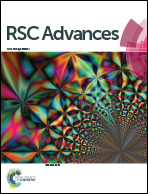Surface-enhanced Raman scattering on a silver film-modified Au nanoparticle-decorated SiO2 mask array
Abstract
Nano-structured Ag and Au with well-defined localized surface plasmon resonance (LSPR) are most popularly employed in surface-enhanced Raman scattering (SERS)-related studies. Ag possesses the highest molar extinction coefficient in metals, resulting in a stronger SERS effect than that of Au. However, compared to Au, the serious decay of SERS enhancement in ambient laboratory air limits its reliable application. In this work, we develop a new strategy for preparing highly SERS-active Ag films deposited on Au nanoparticle (NP)-decorated SiO2 mask arrays based on electrochemical methods. The idea is derived from the underpotential deposition (UPD) of metals, which works on enhancing the SERS effect of underneath Au NPs as well as on reducing the decay of surface Ag films. Experimental results indicate that the SERS of Rhodamine 6G (R6G) absorbed on this developed array exhibits a higher intensity by ca. 30-fold, as compared with that of R6G absorbed on the Au NP-based array without the modification of Ag films. This strategy is also practically applicable to the trace detection of solutions containing calcium pyrophosphate dihydrate (CPPD), which is a common form of calcium crystals found in articular cartilage. In addition, aging (in an atmosphere of 50% relative humidity (RH) and 20% (v/v) O2 at 30 °C for 60 day) of the SERS effect observed on this developed array is significantly depressed, which is comparable to that observed on the Au NP-based array without the modification of Ag films.


 Please wait while we load your content...
Please wait while we load your content...